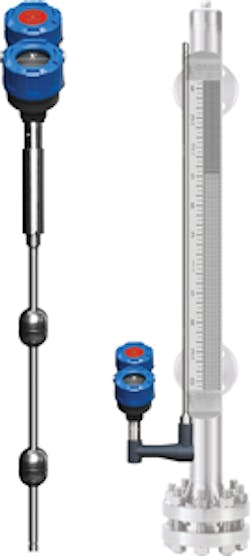Magnetostrictive level loses limitations
Magnetostrictive technology uses the magnetic field of a float to reflect a low-energy signal on a magnetostrictive wire. Using a float can offer advantages over reflective technologies in applications involving foam or where detecting interfaces between layers is critical. Significant advancements in magnetostrictive instruments have been relatively slow in coming, and many current versions lack the sophistication (communication, installation and maintenance) found in other instruments.
"Today's user expects their level measurement instrumentation to be "smart" and feature-rich. We saw an opportunity to reinvigorate our magnetostrictive offering with meaningful, modern, unique features that enhance device accessibility, reliability and the overall user experience," says Eric Moore, marketing manager, Orion Instruments. "Most notably, we developed a removable head with smart probe technology—a first for magnetostrictive devices—so users can swap heads in the field with the assurance that calibration is automatic. Until now, Magnetostrictive transmitter heads have been permanently fixed to their probes. This can make maintenance cumbersome and a spare parts plan very costly."
Orion Instruments' JUPITER JM4 level transmitter offers fieldbus, advanced analytics, improved graphics and a rotatable, removable head to ease installation, operation and support.
The result is the new JUPITER JM4 magnetostrictive level transmitter. The JM4 is available as a direct insertion option, as well as an external mount on any Orion magnetic level indicator (MLI) or modular instrumentation bridle.
The JM4 is engineered to be the smartest, most innovative magnetostrictive transmitter available. Numerous enhancements have been introduced, including greater signal-to-noise ratio (SNR), a full graphic local user interface, HART 7.0 (Foundation fieldbus available), local waveform capture, and a more intuitive device type manager (DTM) allowing for remote configuration, trending and diagnostics.
"It's a significant redesign and upgrade," says Juan Pereira, Orion global strategic planning manager. "Users want ease of use and reliability, both of which are instrumental in their safety programs, and we're providing just that. There is intrinsic value for our customers with the ability to easily rotate or remove the transmitter head from the probe. No other company delivers that feature."
The removable transmitter head simplifies transmitter maintenance and troubleshooting, all without disrupting the process. The angled dual-compartment enclosure, along with 310° of rotation, provides greater accessibility to operate the JM4's on-board graphical interface. A remote-mount option allows the head to be attached to the probe via a 3-ft. or 12-ft. flexible cable for easier viewing.
The JM4 also features smart probe technology: When any JM4 transmitter is attached to a probe, a single push of a button imports factory configuration and calibration settings into the head, and in seconds, the transmitter is ready for operation. Moore says, "The factory configuration resides on a chip inside the probe, so there's no need to recalibrate even if you change the head."
A graphical display on the JM4 provides greater insight into the performance of the instrument, and the actual process can be derived through the use of locally displayed echo curves. "It provides users the ability to interact more effectively with the transmitter, to gain deeper insight into its brain and see what the transmitter sees. This allows the user to determine which adjustments may be needed to optimize performance," Moore says.
Troubleshooting can be performed locally via the display, or from afar through a handheld communicator or EDDL-compatible interface "With its event-based echo capture, JUPITER will store up to 10 time-stamped echo curves to facilitate troubleshooting hours or even days after an isolated or intermittent event," Moore says. Free DTM software can be loaded onto a laptop to access the transmitter at the display or anywhere on the loop. "Operators can see exactly what happened, at what time, and correlate it to the process."
Magnetostrictive technology has advantages, and one of its challenges is that users have not been as familiar with it as they are with other technologies, Moore says. "We are overcoming this by marrying the benefits of buoyancy-based magnetostrictive technology with modern, high-tech electronics and innovative features that elevate JUPITER to a strong consideration for our client's next level application."
For more information visit www.orioninstruments.com.


